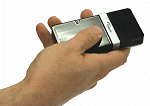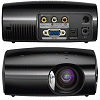Lighting the Way
##AUTHORSPLIT##<--->
T.H.E. Journal's own online editor and techie gives the scoop on breakthroughprojector technologies that are slated to hit the shelves in the coming year.
 AFTER YEARS OF READING about projectiontechnologies that are "just around the corner" butnever quite come into fruition, we'refinally on the cusp of somerevolutionary innovations,from palmsized"pico"projectors todevices withUSB-basedvideo. Thesenew projectortechnologiesbringease of use,portability, andimage quality to newlevels, and shouldgive a boost to your lessons,projects, and presentations. Bestof all, there isn't a lot of waiting to do; some ofthese new technologies are already here, and therest have firm deadlines of later this year or earlynext year.
AFTER YEARS OF READING about projectiontechnologies that are "just around the corner" butnever quite come into fruition, we'refinally on the cusp of somerevolutionary innovations,from palmsized"pico"projectors todevices withUSB-basedvideo. Thesenew projectortechnologiesbringease of use,portability, andimage quality to newlevels, and shouldgive a boost to your lessons,projects, and presentations. Bestof all, there isn't a lot of waiting to do; some ofthese new technologies are already here, and therest have firm deadlines of later this year or earlynext year.
Big Things in Small Packages
The drive toward miniaturization is moving projectors down to new scales this year. After much buzz, Optoma announced officially in mid-June that it will deliver the first pico projector by the end of 2008-- well, in Europe anyway. The United States will have to wait until 2009, but that's not so far away, right?
Based on Texas Instruments' DLP Pico chipset and using an LED-based light source, the Optoma Pico Projector will weigh in at just 4 ounces. It will come in a form similar an iPod or iPhone, but Optoma says it will project an image "up to 100 times larger" than what you get on a handheld device, freeing gadgetophiles from the shackles of their 3-inch screens. As for further specs, we'll just have to wait and see-- Optoma hasn't released any as of this writing.

Samsung P400 Pocket Imager
Meanwhile, other manufacturers have continued the trend toward more incremental miniaturization using traditional projector technologies. In mid-June, Samsung not only debuted but also began shipping its P400 Pocket Imager, a tiny DLP model that weighs a scant 1.9 pounds and measures just 5.8 inches wide and 2.5 inches high.
Despite its size, the P400 manages to crank out an SVGA picture (800 x 600 pixels) with a 1,000:1 contrast ratio. At a brightness rating of only 150 ANSI lumens, it's targeted more for teachers and trainers on the go than for classroom use. And the unit promises a lamp life of 30,000 hours-- about 10 times the average projector bulb's lifespan.
LCoS: A Clear Arrival
Liquid crystal on silicon (LCoS) isn't exactly new, but it isn't exactly widespread, either. Technical difficulties in manufacturing have made it somewhat of a rarity, despite the technology's promise as the ultimate platform for image quality. But Canon USA has made significant progress with the technology, and this fall, it will start shipping the first LCoS-based WUXGA (1,920 x 1,200) projector.

Canon REALiS SX80
The REALiS WUX10 features a 0.71-inch LCoS reflective LCD panel, a contrast ratio of 1,000:1, a brightness of 3,200 ANSI lumens, and a 10-bit pixel depth for outstanding image quality. This portable, 10.8-pound projector is expected to be available in October.
Canon also launched a lower-cost, mid-range LCoS model in June: the REALiS SX80. It offers a 1,400 x 1,050 resolution using a 0.55-inch LCoS reflective LCD panel, a contrast ratio of 900:1, and a brightness of 3,000 ANSI lumens. The SX80 also features USB and PictBridge connectivity for delivering presentations from USB flash drives or PictBridge-enabled cameras, and weighs in at an easy-to-carry 11.5 pounds.
USB Projection

InFocus IN1100
Although USB connectivity on projectors is common, using USB instead of a regular display connector to transmit video from a computer to a projector is certainly new-- and helps cut down on display setup hassles. Over the summer, projector manufacturer InFocus introduced two lines that use this new USB display technology called DisplayLink. InFocus didn't invent DisplayLink, but it's the first projector company to put projectors with that technology into production with its IN1100 and IN3100 series.

Canon REALiS WUX10
The IN1100 is an ultraportable projector-- only 2.75 pounds-- with XGA (1,024 x 768) resolution and up to 2,100 ANSI lumens of brightness. The IN1102 offers an additional 100 lumens of brightness and the option of using WXGA (1,366 x 768) resolution to display from widescreen computers. The IN3100 series also includes an HDMI port, and support for LiteShow II wireless networking for use with wireless computers. Projectors in this series feature a 2,000:1 contrast ratio, a brightness of 3,000 to 3,500 ANSI lumens, and a choice of XGA or WXGA resolution. At 7 pounds, these projectors can also be easily carried.
According to DisplayLink, its technology will work with solutions like Iogear's USB-IF Certified Wireless USB solution-- a technology that was shown off earlier this year at the Consumer Electronics Show in Las Vegas. But as of press time, there hasn't been any word on whether such a wireless USB solution has been successfully coupled with a DisplayLink-enabled projector.

InFocus IN3100
Projectors with this new USB technology do require drivers from DisplayLink to function. As of this writing, these drivers are available for Windows 2000, Windows XP (32-bit), and Windows Vista (32-bit) only. A driver is in the works for Mac OS X and is currently available in beta form for Tiger and Leopard, but without support for OpenGL and without 2D acceleration. However, DisplayLink says it will make these features available in the final driver release.
Whether your school decides to get on board with these innovative projector technologies for a media upgrade or its first projector purchase, be sure to check in with each manufacturer for further specs and pricing information.
Dave Nagel is the executiveonline editor for 1105 Media'seducation technology publications.
This article originally appeared in the 08/01/2008 issue of THE Journal.